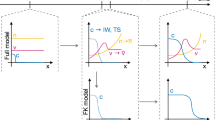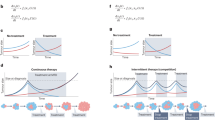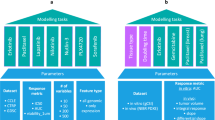Abstract
At the dawn of the era of personalized, systems-driven medicine, computational or in silico modeling and the simulation of disease processes is becoming increasingly important for hypothesis generation and data integration in both experiments and clinics alike. Arguably, the use of these techniques is nowhere more visible than in oncology. To illustrate the field's vast potential, as well as its current limitations, we briefly review selected studies on modeling malignant brain tumors. Implications for clinical practice, and for clinical trial design and outcome prediction, are also discussed.
Key Points
-
In generating experimentally testable hypotheses and facilitating multimodality data integration, in silico modeling is a driving force behind cancer systems biology
-
As exemplified by reviewing selected works on malignant brain tumors, practical applications for computational and mathematical cancer modeling reach from simulating aspects of tumor initiation and progression to modeling of treatment effect
-
In silico modeling is a tool geared to aiding experimental researchers and physicians in investigating the complex processes involved in tumorigenesis, thus supporting innovative discovery research and accelerating the identification of promising targets
-
Although there is no single simulator platform that fits all needs, discrete–continuum (hybrid) modeling, especially agent-based approaches, is particularly promising in integrating molecular, microscopic and macroscopic oncology data and in analyzing processes across scales in space and time
This is a preview of subscription content, access via your institution
Access options
Subscribe to this journal
Receive 12 print issues and online access
$209.00 per year
only $17.42 per issue
Buy this article
- Purchase on Springer Link
- Instant access to full article PDF
Prices may be subject to local taxes which are calculated during checkout


Similar content being viewed by others
References
Liu ET et al. (2006) In the pursuit of complexity: systems medicine in cancer biology. Cancer Cell 9: 245–247
Kitano H (2002) Computational systems biology. Nature 420: 206–210
Hornberg JJ et al. (2006) Cancer: a systems biology disease. Biosystems 83: 81–90
Coffey DS (1998) Self-organization, complexity and chaos: the new biology for medicine. Nat Med 4: 882–885
Ahn AC et al. (2006) The clinical applications of a systems approach. PLoS Med 3: e209
The Integrative Cancer Biology Program [http://icbp.nci.nih.gov/]
Anderson AR et al. (2006) Tumor morphology and phenotypic evolution driven by selective pressure from the microenvironment. Cell 127: 905–915
Axelrod R et al. (2006) Evolution of cooperation among tumor cells. Proc Natl Acad Sci USA 103: 13474–13479
Gatenby RA and Vincent TL (2003) An evolutionary model of carcinogenesis. Cancer Res 63: 6212–6220
Mansury Y et al. (2006) Evolutionary game theory in an agent-based brain tumor model: exploring the 'Genotype-Phenotype' link. J Theor Biol 238: 146–156
Guiot C et al. (2003) Does tumor growth follow a “universal law”. J Theor Biol 225: 147–151
Guiot C et al. (2006) The dynamic evolution of the power exponent in a universal growth model of tumors. J Theor Biol 240: 459–463
Baish JW and Jain RK (2000) Fractals and cancer. Cancer Res 60: 3683–3688
Cross SS (1997) Fractals in pathology. J Pathol 182: 1–8
Norton L (2005) Conceptual and practical implications of breast tissue geometry: toward a more effective, less toxic therapy. Oncologist 10: 370–381
Goh KI et al. (2007) The human disease network. Proc Natl Acad Sci USA 104: 8685–8690
Marusic M et al. (1994) Analysis of growth of multicellular tumour spheroids by mathematical models. Cell Prolif 27: 73–94
Vaidya VG and Alexandro FJ Jr (1982) Evaluation of some mathematical models for tumor growth. Int J Biomed Comput 13: 19–36
Alarcon T et al. (2003) A cellular automaton model for tumour growth in inhomogeneous environment. J Theor Biol 225: 257–274
Bauer AL et al. (2007) A cell-based model exhibiting branching and anastomosis during tumor-induced angiogenesis. Biophys J 92: 3105–3121
McDougall SR et al. (2006) Mathematical modelling of dynamic adaptive tumour-induced angiogenesis: clinical implications and therapeutic targeting strategies. J Theor Biol 241: 564–589
Plank MJ and Sleeman BD (2004) Lattice and non-lattice models of tumour angiogenesis. Bull Math Biol 66: 1785–1819
Sole RV and Deisboeck TS (2004) An error catastrophe in cancer. J Theor Biol 228: 47–54
Spencer SL et al. (2006) Modeling somatic evolution in tumorigenesis. PLoS Comput Biol 2: e108
Castiglione F et al. (2005) Computational modeling of the immune response to tumor antigens. J Theor Biol 237: 390–400
Wu JT et al. (2004) Analysis of a three-way race between tumor growth, a replication-competent virus and an immune response. Bull Math Biol 66: 605–625
Sanga S et al. (2007) Predictive oncology: a review of multidisciplinary, multiscale in silico modeling linking phenotype, morphology and growth. Neuroimage 37 (Suppl 1): S120–S134
Greenspan HP (1972) Models for the growth of a solid tumor by diffusion. Stud Appl Math: 317–340
Greenspan HP (1976) On the growth and stability of cell cultures and solid tumors. J Theor Biol 56: 229-242
Chaplain MA and Sleeman BD (1993) Modelling the growth of solid tumours and incorporating a method for their classification using nonlinear elasticity theory. J Math Biol 31: 431–473
Zheng X et al. (2005) Nonlinear simulation of tumor necrosis, neo-vascularization and tissue invasion via an adaptive finite-element/level-set method. Bull Math Biol 67: 211–259
Khain E and Sander LM (2006) Dynamics and pattern formation in invasive tumor growth. Phys Rev Lett 96: 188103
Frieboes HB et al. (2006) An integrated computational/experimental model of tumor invasion. Cancer Res 66: 1597–1604
Wasserman R and Acharya R (1996) A patient-specific in vivo tumor model. Math Biosci 136: 111–140
Clatz O et al. (2005) Realistic simulation of the 3-D growth of brain tumors in MR images coupling diffusion with biomechanical deformation. IEEE Trans Med Imaging 24: 1334–1346
Konukoglu E et al. (2007) A recursive anisotropic fast marching approach to reaction diffusion equation: application to tumor growth modeling. Inf Process Med Imaging 20: 687–699
Zienkiewicz OC (1977) The Finite Element Method, edn 3. London: NCGraw-Hill
Burgess PK et al. (1997) The interaction of growth rates and diffusion coefficients in a three-dimensional mathematical model of gliomas. J Neuropathol Exp Neurol 56: 704–713
Cruywagen GC et al. (1995) The modeling of diffusive tumors. J Biol System 3: 937–945
Tracqui P et al. (1995) A mathematical model of glioma growth: the effect of chemotherapy on spatio-temporal growth. Cell Prolif 28: 17–31
Woodward DE et al. (1996) A mathematical model of glioma growth: the effect of extent of surgical resection. Cell Prolif 29: 269–288
Burger PC et al. (1994) Tumors of the Central Nervous Systems, edn 3. Washington, DC: Armed Forces Institute Pathology
Kleihues P et al. (1993) The new WHO classification of brain tumours. Brain Pathol 3: 255–268
Kleihues P et al. (1993) Histological Typing of Tumors of the Central Nervous System, edn 2. Berlin: Springer
Swanson KR et al. (2000) A quantitative model for differential motility of gliomas in grey and white matter. Cell Prolif 33: 317–329
Swanson KR et al. (2002) Virtual brain tumours (gliomas) enhance the reality of medical imaging and highlight inadequacies of current therapy. Br J Cancer 86: 14–18
Orme ME and Chaplain MA (1997) Two-dimensional models of tumour angiogenesis and anti-angiogenesis strategies. IMA J Math Appl Med Biol 14: 189–205
Kansal AR et al. (2000) Simulated brain tumor growth dynamics using a three-dimensional cellular automaton. J Theor Biol 203: 367–382
Kansal AR et al. (2000) Cellular automaton of idealized brain tumor growth dynamics. Biosystems 55: 119–127
Wolfram S (1994) Cellular Automata and Complexity: Collected Papers. Reading, MA: Addison-Wesley
Deisboeck TS et al. (2001) Pattern of self-organization in tumour systems: complex growth dynamics in a novel brain tumour spheroid model. Cell Prolif 34: 115–134
Mansury Y and Deisboeck TS (2003) The impact of “search precision” in an agent-based tumor model. J Theor Biol 224: 325–337
Mansury Y et al. (2002) Emerging patterns in tumor systems: simulating the dynamics of multicellular clusters with an agent-based spatial agglomeration model. J Theor Biol 219: 343–370
Athale C et al. (2005) Simulating the impact of a molecular 'decision-process' on cellular phenotype and multicellular patterns in brain tumors. J Theor Biol 233: 469–481
Athale CA and Deisboeck TS (2006) The effects of EGF-receptor density on multiscale tumor growth patterns. J Theor Biol 238: 771–779
Ohgaki H and Kleihues P (2007) Genetic pathways to primary and secondary glioblastoma. Am J Pathol 170: 1445–1453
Mellinghoff IK et al. (2005) Molecular determinants of the response of glioblastomas to EGFR kinase inhibitors. N Engl J Med 353: 2012–2024
Zhang L et al. (2007) Development of a three-dimensional multiscale agent-based tumor model: simulating gene-protein interaction profiles, cell phenotypes and multicellular patterns in brain cancer. J Theor Biol 244: 96–107
Schoeberl B et al. (2002) Computational modeling of the dynamics of the MAP kinase cascade activated by surface and internalized EGF receptors. Nat Biotechnol 20: 370–375
Alarcon T et al. (2004) A mathematical model of the effects of hypoxia on the cell-cycle of normal and cancer cells. J Theor Biol 229: 395–411
Frieboes HB et al. (2007) Computer simulation of glioma growth and morphology. Neuroimage 37 (Suppl 1): S59–S70
Swanson KR et al. (2002) Quantifying efficacy of chemotherapy of brain tumors with homogeneous and heterogeneous drug delivery. Acta Biotheor 50: 223–237
Sanga S et al. (2006) Mathematical modeling of cancer progression and response to chemotherapy. Expert Rev Anticancer Ther 6: 1361–1376
Kirkby NF et al. (2007) A mathematical model of the treatment and survival of patients with high-grade brain tumours. J Theor Biol 245: 112–124
Kirkby NF et al. (2007) Mathematical modelling of survival of patients with glioblastoma following radical and palliative radiotherapy. Clin Oncol (R Coll Radiol) 19: S35–S36
Dionysiou DD et al. (2004) A four-dimensional simulation model of tumour response to radiotherapy in vivo: parametric validation considering radiosensitivity, genetic profile and fractionation. J Theor Biol 230: 1–20
Fowler JF (1989) The linear-quadratic formula and progress in fractionated radiotherapy. Br J Radiol 62: 679–694
Stamatakos GS et al. (2006) A four-dimensional computer simulation model of the in vivo response to radiotherapy of glioblastoma multiforme: studies on the effect of clonogenic cell density. Br J Radiol 79: 389–400
Araujo RP et al. (2005) A mathematical model of combination therapy using the EGFR signaling network. Biosystems 80: 57–69
Hu L et al. (2007) Computational modeling to predict effect of treatment schedule on drug delivery to prostate in humans. Clin Cancer Res 13: 1278–1287
Jaffer FA and Weissleder R (2005) Molecular imaging in the clinical arena. JAMA 293: 855–862
Center for the Development of a Virtual Tumor [https://www.cvit.org]
Deisboeck TS et al. (2007) Advancing cancer systems biology: introducing the Center for the Development of a Virtual Tumor, CViT. Cancer Informatics: 1–8
Zhang L et al. (2008) Simulating brain tumor heterogeneity with a multiscale agent-based model: linking molecular signatures, phenotypes and expansion rate. Math Comput Model (in press) [10.1016/j.mcm.2008.05.011]
Acknowledgements
This work has been supported, in part, by NIH grants CA 085139 and CA 113004 (CViT; https://www.cvit.org) and by the Harvard-MIT (HST) Athinoula A Martinos Center for Biomedical Imaging and the Department of Radiology at Massachusetts General Hospital.
Author information
Authors and Affiliations
Corresponding author
Ethics declarations
Competing interests
The authors declare no competing financial interests.
Rights and permissions
About this article
Cite this article
Deisboeck, T., Zhang, L., Yoon, J. et al. In silico cancer modeling: is it ready for prime time?. Nat Rev Clin Oncol 6, 34–42 (2009). https://doi.org/10.1038/ncponc1237
Received:
Accepted:
Published:
Issue Date:
DOI: https://doi.org/10.1038/ncponc1237
This article is cited by
-
Computational reactive–diffusive modeling for stratification and prognosis determination of patients with breast cancer receiving Olaparib
Scientific Reports (2023)
-
Nanoparticle-mediated cancer cell therapy: basic science to clinical applications
Cancer and Metastasis Reviews (2023)
-
Mathematical computation of the tumor growth
Network Modeling Analysis in Health Informatics and Bioinformatics (2022)
-
Combination chemotherapy versus temozolomide for patients with methylated MGMT (m-MGMT) glioblastoma: results of computational biological modeling to predict the magnitude of treatment benefit
Journal of Neuro-Oncology (2021)
-
In silico modelling of cancer nanomedicine, across scales and transport barriers
npj Computational Materials (2020)



